Corpus Christi in Spain
Corpus Christi (in latin Body of Christ) is a Christian festival honouring the Eucharist. It is celebrated on Thursday following Trinity Sunday. Corpus Christi is celebrated by the Roman Catholic Church, the Church of England and some other Anglican churches.
The date for celebration is not fixed. It varies according to the date of Easter. In 2013 Corpus Christi will be celebrated on the 30th of May.
The most common way of celebrating Corpus Christi is a procession through cities and towns. But each place has some other traditions that accompany the procession.
L'ou com Balla or the "Dancing Egg" has been celebrated in Barcelona since the 15th century. Can eggs really dance? Well, people of Barcelona put emptied white eggshells above the water jets of local fountains. It looks like the egg is dancing.
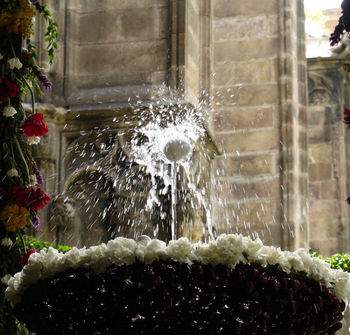 L'ou com Balla or the Dancing Egg
L'ou com Balla or the Dancing Egg
The eggshell symbolises the body of Christ. The water represents a renewal. It is believed that if the egg does not break, the year ahead is going to be a good one.
The fountains are decorated with flowers. The most impressive L'ou com Balla is at the fountain of Saint Jordi (George) in the Cathedral's cloister. Other place in the city where the event can be seen are the parish church of Santa Anna, the Museu Marès, Ca l'Ardiaca etc.
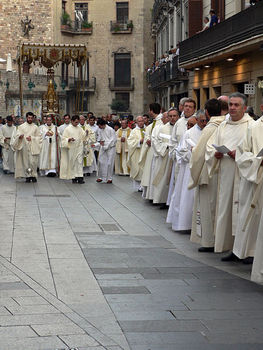 Corpus Christi procession in Barcelona
Corpus Christi procession in Barcelona
The Corpus Christi procession in Barcelona has a very long history. The first one was in 1320. The procession has some elements of Catalan folklore - "gegants, capgrossos, bestiari fantàstic" (giants, big heads, imaginary beasts). From 1992 on the procession includes huge figures of giants and dwarves, the Eagle, the Lion, the Dragon and other creatures.
Also in Catalonia there is a town of Berga. To celebrate Corpus Christi locals organize the Patum de Berga or La Patum. It includes parades with all kind of strange mythical creatures. Those involved in the La Patum are El Tabal (The Drum), Turcs i Cavallets (Turks and Little Horses), Les Maces (The Maces), Les Guites (The Mules), L'Àliga (The Eagle), Els Nans Vells (The Old Dwarves), Els Gegants (The Giants), Els Nans Nous (The New Dwarves) and Els Plens (The "Plens").
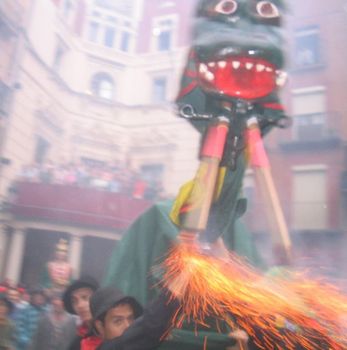 La Guita Xica dragon
La Guita Xica dragon
The most popular character in this parade is "La Guita Xica". It is a dragon from Catalan folklore. It protects people of Catalonia. It has shiny eyes, green body, very long neck and fangs. In the past it was called "Mulaguita". Originally it was sort of mule which often used to kick with its foot.
In Valencia people organize Cabalgata del Convite and Parade of the Rocas. Cabalgata del Convite is a parade of medieval origin. It includes people wearing all sort of old costumes. The "Degolla" is a group of men representing supporters of King Herod. They symbolize the slaughter of innocent infants which was according to the Bible organize by King Herod.
The parade among others also includes the "momos" which are groups of seven demons. They are symbols of sins. They dance around the lady in white called La Moma. She is a symbol of virtue. People from nearby balconies traditionally pour water upon those participating in the parade.
Rocas are one of symbols of Valencia. They are actually wagons pulled by horses. On each wagon there is a sculpture representing one motive from the Bible. There are 11 rocas. The oldest was built in 1512 and the newest is from 2001.
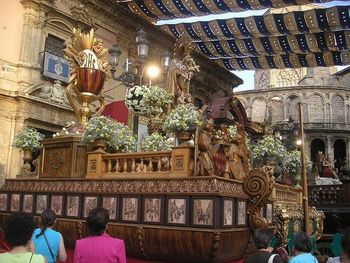 Roca
Roca
The parade is very spectacular. It lasts for about 10 minutes. The final part of event is just before the hill where the Archiepiscopal Palace is located. There each Roca is left with only one horse. The wagons then continue to the top. It is very difficult. The audience is cheering, bets are made.
Let's now move to central Spain. Just 70 km south of Madrid there is a city of Toledo. This beautiful old city was declared a World Heritage Site by UNESCO in 1986. Local Corpus Christi procession includes the Arfe monstrance which is carried through the city. The monstrance was built in 1524.
People in the procession wear colourful medieval costumes. The Illescas nobles wear red clothes, the knights of the Holy Sepulchre are dressed in white, the Mozarabic knights are dressed in blue and the knights of Corpus Christi are dressed in green.
Granada is a city in southern Spanish province of Andalucia. They celebrate Corpus Christi too. This city has actually two processions. One includes funny gigantic characters, lot of folk music etc. The most popular character in this procession is "La Tarasca" which is a huge dragon originally from town of Tarascon in French Provence region. During the procession a woman rides the dragon. The more quiet religious procession is organized three days later, on Corpus Christi sunday.
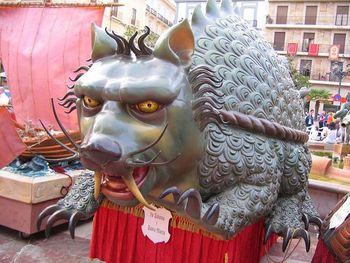 La Tarasca dragon
La Tarasca dragon
In the city of Seville a mass is celebrated in local cathedral. Groups of boys wearing special red and gold clothes sing and dance during this Corpus Christi mass. They are called the "Seise." The Corpus Christi procession through the streets of Seville includes numerous platforms with sacred figures. The most famous of them is the statue of "Custodia."
Let's finish this article on the island of La Palma which belongs to Spanish Canary Islands. Small town called Villa de Mazo has a nice Corpus Christi celebration. People use flowers, shells, sand, moss and other natural materials do decorate their town for the occasion.